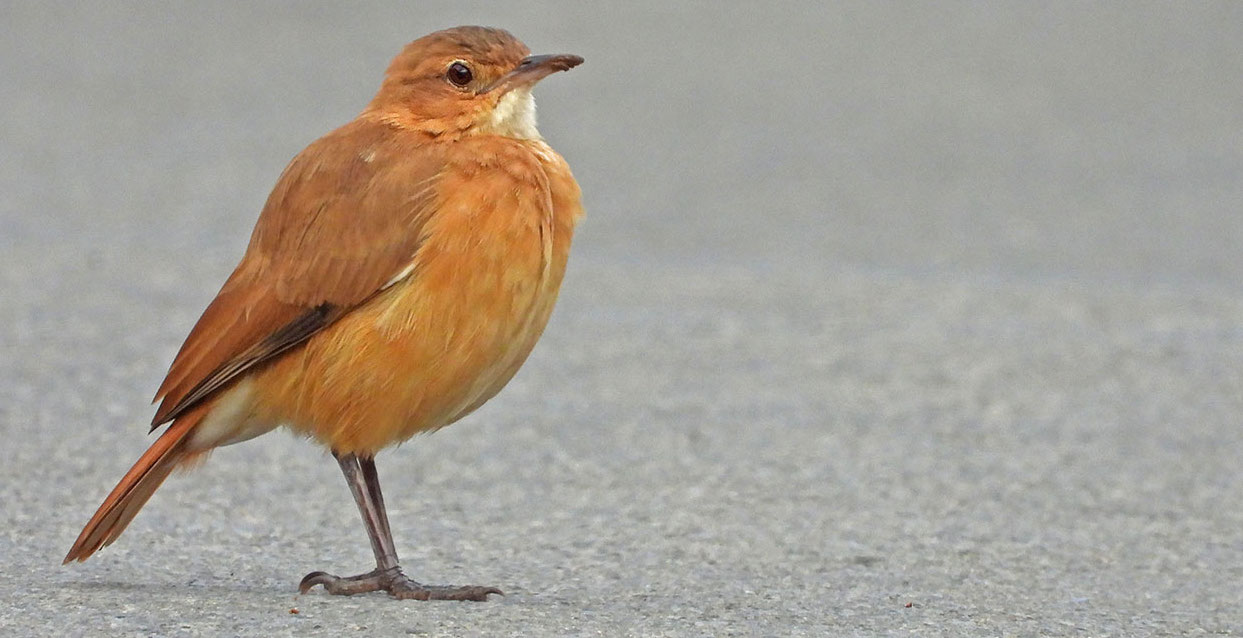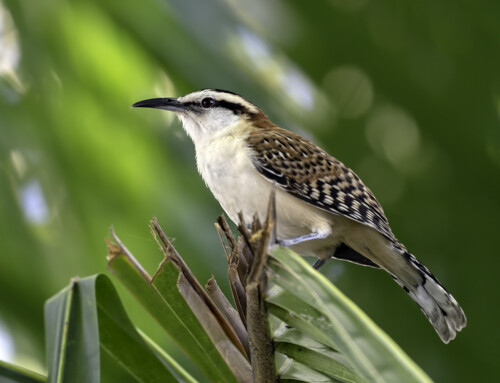LINKED PAPER
Urban cycles of human activity do not significantly alter the behaviour of a duetting bird. Diniz, P., Silva-Jr, E.F. & Macedo, R.H. 2021 IBIS. DOI: 10.1111/ibi.12956 VIEW
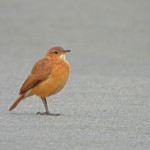 Working five days and resting two are part of a typical routine in people’s lives. Weekly, the large flows of people change the urban environment, vehicles occupy the streets and background sounds and noises emerge. In this scenario, we could imagine that the weekly cycles of human activity influence animal behaviour, the so-called “weekend effect hypothesis” (Stalmaster & Kaiser 1998). Indeed, when human presence is higher in one area, animals can respond by becoming more vigilant (Tarjuelo et al. 2015), spending less time searching for food (i.e., foraging) (Payne et al. 2014) or even by increasing their home range size (Perona et al. 2019). Overall, this dynamic level of human activity has been shown to affect animals’ behaviours in natural environments (Blumstein et al. 2017), but few studies have explored how urban species face this temporally dynamic level of human activity (e.g. Fernández-Juricic & Tellería 2000).
Working five days and resting two are part of a typical routine in people’s lives. Weekly, the large flows of people change the urban environment, vehicles occupy the streets and background sounds and noises emerge. In this scenario, we could imagine that the weekly cycles of human activity influence animal behaviour, the so-called “weekend effect hypothesis” (Stalmaster & Kaiser 1998). Indeed, when human presence is higher in one area, animals can respond by becoming more vigilant (Tarjuelo et al. 2015), spending less time searching for food (i.e., foraging) (Payne et al. 2014) or even by increasing their home range size (Perona et al. 2019). Overall, this dynamic level of human activity has been shown to affect animals’ behaviours in natural environments (Blumstein et al. 2017), but few studies have explored how urban species face this temporally dynamic level of human activity (e.g. Fernández-Juricic & Tellería 2000).
We investigated how the weekly cycle of human activity affects the behaviour of an urban-dwelling bird, the Rufous Hornero (Furnarius rufus), in Brasília, Brazil. Rufous Horneros are ovenbirds commonly found in cities of central Brazil. Their heavy domed nests are made of clay and are easy to find, integrated throughout the urban landscape (Shibuya et al. 2015). We usually see social pairs foraging on the ground, and both male and female frequently perch on trees or light posts and engage in coordinated duets to defend their territory and the pair bond (Diniz et al. 2018, 2020).
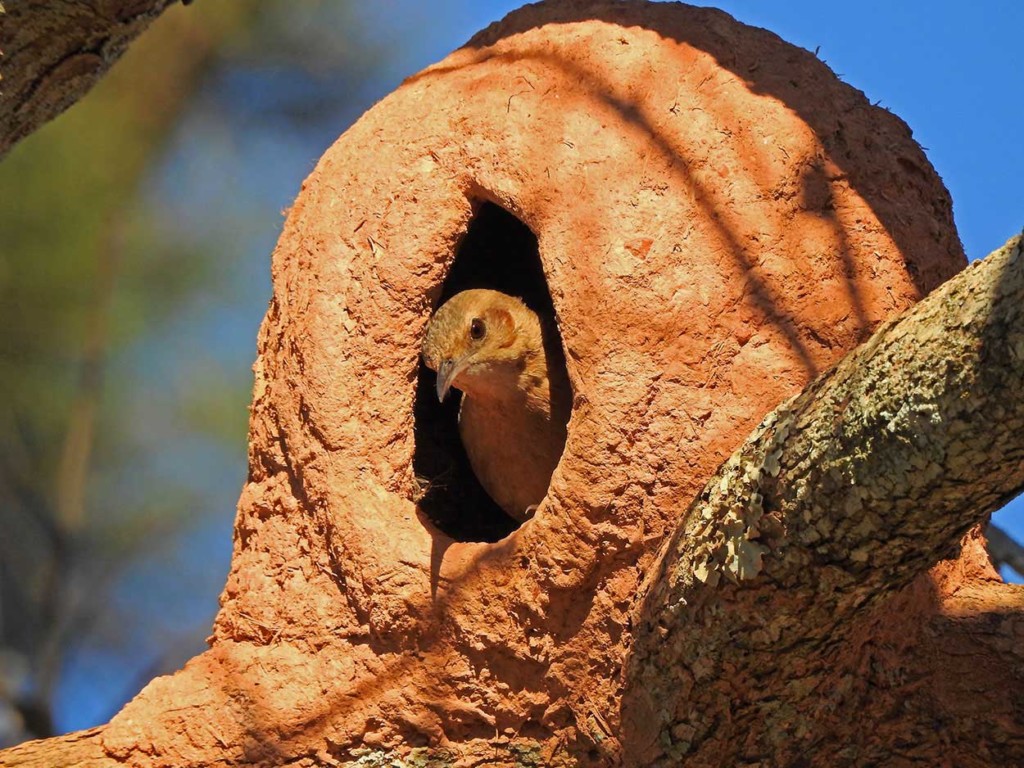 Figure 1 Rufous Hornero within its domed nest made of clay © Guilherme Carrano
Figure 1 Rufous Hornero within its domed nest made of clay © Guilherme Carrano
Are human activity levels higher on weekdays?
We studied social pairs of horneros during seven months at the University of Brasília in 2015, where a total of 50,000 people are concentrated on campuses (Werneck & Arruda 2017). The first question we had was whether the urban environment of the campus changed between weekdays and weekends. We found that human activity, expressed as number of people, vehicles and background noise, was remarkably higher on weekdays than on weekends. Then, we compared foraging, sentinel (vigilance from a high perch) and vocal behaviour of the Rufous Horneros between these two moments of the week.
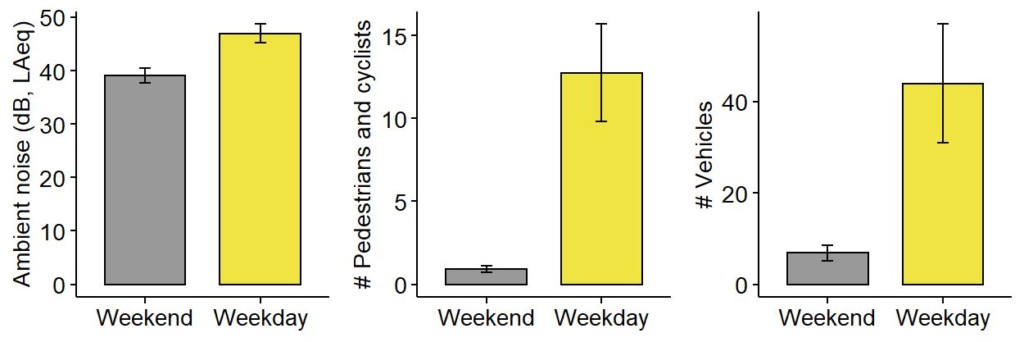 Figure 2 Human activities measured for 5-min periods both on a weekend day and on a weekday at Rufous Hornero territories. Figure modified from Diniz et al. 2021.
Figure 2 Human activities measured for 5-min periods both on a weekend day and on a weekday at Rufous Hornero territories. Figure modified from Diniz et al. 2021.
Little support for the weekend effect hypothesis
Contrary to our expectations, we found that the horneros’ behaviours mostly did not change between weekdays and weekends. Our models pointed out that the birds spend a half hour more as sentinels and 14-36 minutes less foraging per day during weekdays when compared to weekends; however, these results were not statistically significant.
Moreover, despite noisier weekdays, horneros mostly did not change their vocal behaviour with weekly cycles of human activity. The likelihood of males or females singing solo songs, starting duets and answering partner-initiated duets was similar during weekdays and weekends. Additionally, the duration and the pitch of the duets did not change either, except for a slightly higher (~80 Hz) maximum frequency on weekends. Considering that ovenbirds are suboscine passerines with constrained vocal plasticity (Liu et al. 2013), perhaps our findings reflect this limited capacity of the species to make vocal adjustments in response to new and fast environmental shifts in conditions.
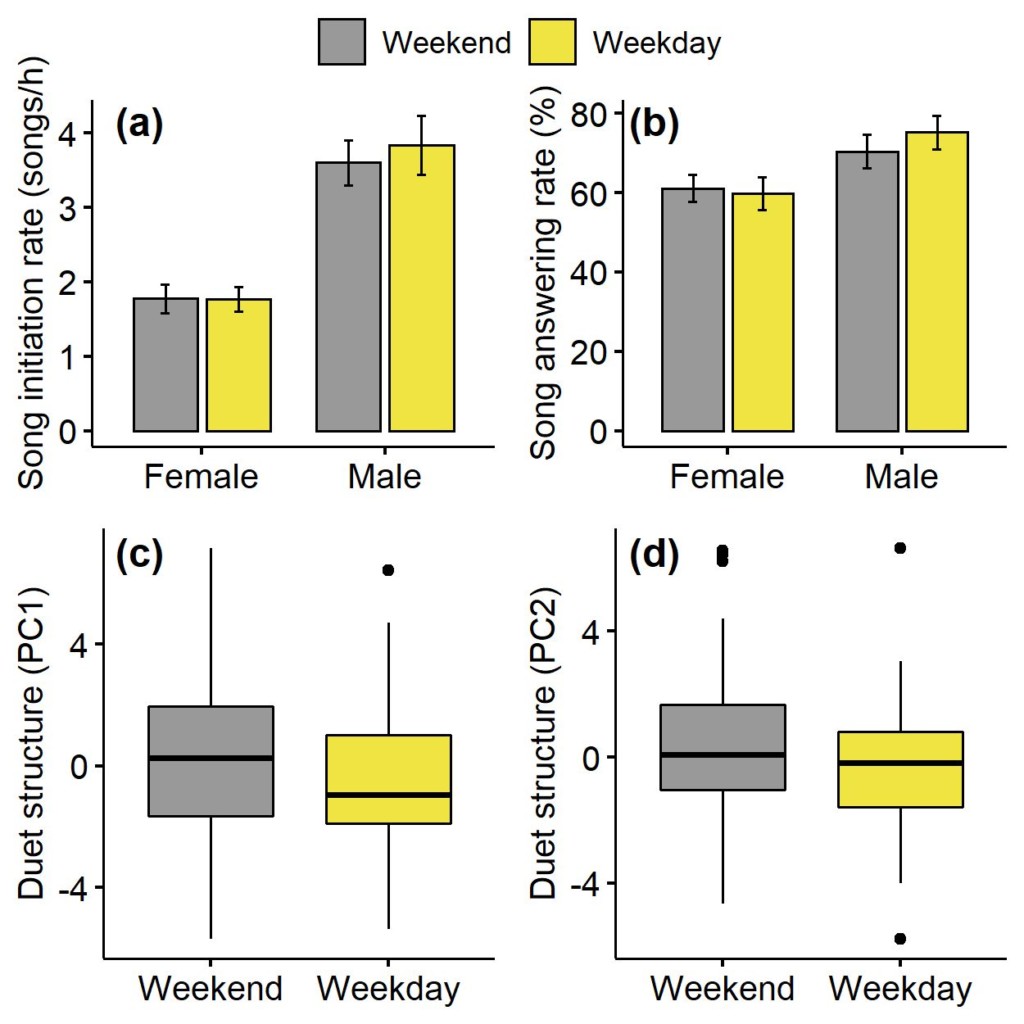 Figure 3 Vocal behaviour and acoustic structure of duets on weekends and weekdays. Duet structure (PC1) is a composite measure in which higher values represent broadband duets with higher entropy. Duet structure (PC2) is another composite measure in which higher values represent higher-pitched duets with high maximum frequency. Figure modified from Diniz et al. 2021.
Figure 3 Vocal behaviour and acoustic structure of duets on weekends and weekdays. Duet structure (PC1) is a composite measure in which higher values represent broadband duets with higher entropy. Duet structure (PC2) is another composite measure in which higher values represent higher-pitched duets with high maximum frequency. Figure modified from Diniz et al. 2021.
Taken together, our results highlight that Rufous Horneros could be habituated to the dynamic changes imposed by human cycles of activity. Alternatively, it is possible that the lower levels of human activity on the weekend are already elevated enough to trigger changes in hornero behaviour.
References
Blumstein, D.T., Geffroy, B., Samia, D.S.M. & Bessa, E. 2017. Ecotourism’s Promise and Peril: A Biological Evaluation. Springer, New York, NY. VIEW
Diniz, P., da Silva, E.F., Webster, M.S. & Macedo, R.H. 2018. Duetting behavior in a Neotropical ovenbird: sexual and seasonal variation and adaptive signaling functions. Journal of Avian Biology 49: 1–12. VIEW
Diniz, P., Rech, G.S., Ribeiro, P.H.L., Webster, M.S. & Macedo, R.H. 2020. Partners coordinate territorial defense against simulated intruders in a duetting ovenbird. Ecology and Evolution 10: 81–92. VIEW
Fernández-Juricic, E. & Tellería, J.L. 2000. Effects of human disturbance on spatial and temporal feeding patterns of Blackbird Turdus merula in urban parks in Madrid, Spain. Ecology and Evolution 10: 81–92. VIEW
Liu, W., Wada, K., Jarvis, E.D. & Nottebohm, F. 2013. Rudimentary substrates for vocal learning in a suboscine. Nature Communications 4: 2082. VIEW
Payne, N.L., van der Meulen, D.E., Suthers, I.M., Gray, C.A. & Taylor, M.D. 2014. Foraging intensity of wild mulloway Argyrosomus japonicus decreases with increasing anthropogenic disturbance. Marine Biology 162: 539–546. VIEW
Perona, A.M., Urios, V. & López-López, P. 2019. Holidays? Not for all. Eagles have larger home ranges on holidays as a consequence of human disturbance. Biological Conservation 231: 59–66. VIEW
Shibuya, F.L.S., Braga, T. V & Roper, J.J. 2015. The Rufous Hornero (Furnarius rufus) nest as an incubation chamber. Journal of Thermal Biology 47: 7–12. VIEW
Stalmaster, M. V & Kaiser, J.L. 1998. Effects of recreational activity on wintering bald eagles. Wildlife Monographs 137: 3–46. VIEW
Tarjuelo, R., Barja, I., Morales, M.B., Traba, J., Benítez-López, A., Casas, F., Arroyo, B., Delgado, M.P. & Mougeot, F. 2015. Effects of human activity on physiological and behavioral responses of an endangered steppe bird. Behavioral Ecology 26: 828–838. VIEW
Werneck, R.O. & Arruda, F.S. de. 2017. Application of a methodology for the spatial analysis of air pollutant levels at the Darcy Ribeiro campus of the University of Brasília. WIT Transactions on the Built Environment 176: 351–360. VIEW
Image credit
Top right: Rufous Hornero Furnarius rufus © Edvaldo Silva-Jr


